15 Amazing Facts About Coral Reefs
Coral reefs are one of the most diverse ecosystems on Earth. The colourful creatures are found across some of the Earth’s water bodies. You’ve probably heard about the Great Barrier Reef of Australia and the stunning array of corals on display. Or the famed red corals of the Red Sea that give it its iconic name.
Like many of the wonders of the marine biosphere, corals play an essential role in the ecosystem. While you may not have seen coral, it impacts your life unimaginably.
This article will look at 15 amazing facts about coral reefs and the abundant diversity they bring to our planet.

1. Coral Reefs Are Animals, Not Plants
Most people know that corals are rooted in the sea bed, which is why there is a common misconception that it is a plants. In reality, corals are animals classified as Cnidarians, related to jellyfish and anemones.
The coral consists of a central polyp surrounded by a hard exoskeleton. The polyp is a living creature that only measures a few millimetres in diameter.
It is a cylindrical vase-shaped creature that has tiny tentacles at one end. These appendages pass food into the mouth of the polyp.
Polyps are generally attached to the substrate they grow on, using a pedal disc that bores into the stratum. They secrete calcium carbonate that forms an external shell.
Over millions of years, this exoskeleton grows to form a coral. Polyps reproduce to form planulae that increase the coral reef coverage area.
2. There Are Different Types Of Coral Reefs
Numerous types of coral reefs can be found across the Earth. They differ in formation, structure, and location. These are:
1. Fringing reef (Shore reef): These reefs grow close to the shore, thrive in shallow water, and are commonly found near the coastline.
They are not very wide but can grow for kilometres along the shore. Fringing corals begin to grow from the coast and spread outwards to the Sea as time passes.
These corals grow at a uniform depth until the end of the continental plate. They also give rise to fringing lagoons as the coral close to the shore erodes over time to form a bowl-like depression. A famous fringing reef is the Red Sea corals.
2. Barrier reef: Recognizable from the Australian Great Barrier Reef, the Belize Barrier Reef, and the New Caledonian Barrier Reef, these coral reefs grow close to the end of a continental plate.
Unlike fringing reefs, they are sparsely found close to the shore but are densely populated at the location where the sea bed sharply drops. Barrier reefs form lagoons that span hundreds of meters and take a long time to grow fully.
They are rare and are responsible for creating lagoons near the coasts of the Caribbean, the Comoros archipelago, French Polynesia, Indonesia, New Guinea, and the Louisiade Archipelago.
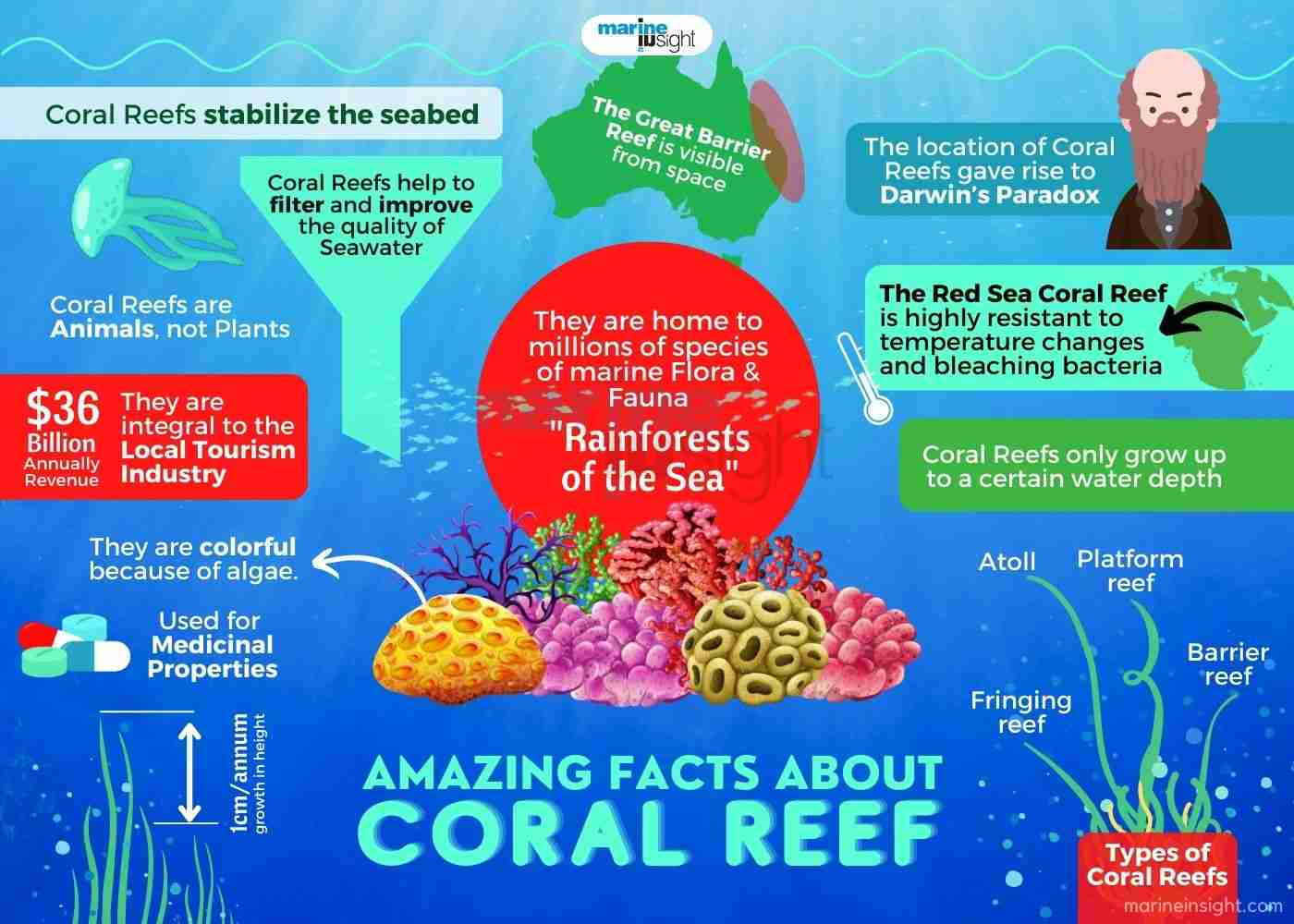
3. Platform reef: These reefs are wider at the top and near the sea bed and are commonly found in shallow regions. These reefs grow on the continental shelf and can be located away from the coastline.
They grow outwards from the main coral polyp and often span a few kilometres in width. Over time, erosion in the middle of the platform reef creates lagoons in the middle of the open ocean.
These reefs are commonly found within atolls and grow in different shapes based on wind and water flow.
4. Atoll: An atoll is a circular coral reef that has a lagoon in the middle. Atolls take millions of years to form. Scientists have theorized that atolls are fringing reefs that form around small and low-elevation islands.
Over time, these islands gradually erode below the surface while the corals continue to grow. This creates a ring of corals and a lagoon.
These reefs are commonly found in the Pacific and Indian oceans. The Maldives, located in the Indian Ocean, is a series of 26 atolls forming an archipelago.
Besides these four common and main types, there are other formations such as the bank, patch, ribbon, Habili, apron, cays, and Guyot reef.
3. They Are One Of The Slowest Growing Creatures On Earth
Corals have calcium-carbonate skeletons and cover large areas. They are one of the slowest growing creatures on Earth, with an estimated 1-centimetre growth in height per annum.
A coral reef spreading just a few square kilometres would have taken around 1 million years to grow.
The growth rate of coral depends on several factors, such as nutrition and water quality. While the average growth is 2 centimetres at some locations, a healthy coral that habitats in an area with sufficient sunlight and no pollution would quickly grow over 10 centimetres a year.
To process how slow this translates to, the Great Barrier Reef covers an area of roughly 350,000 square kilometres.
The first corals on this reef were estimated to have started growing 25 million years ago at a rate of 7 centimetres per year (higher than the worldwide average). A reef base was formed roughly 2 million years ago.
4. Coral Reefs Only Grow Up To A Certain Water Depth
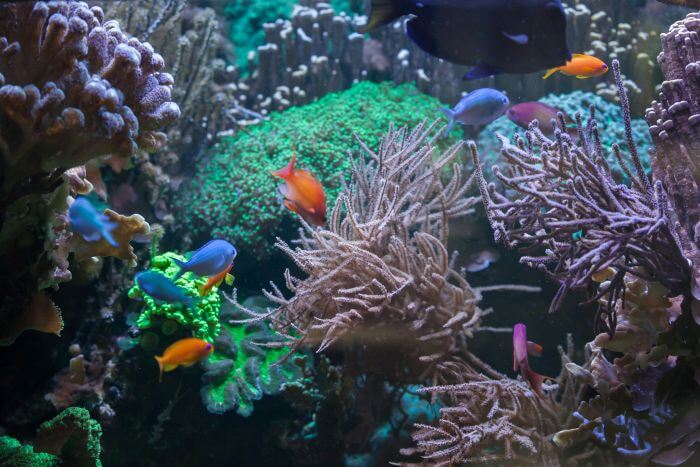
Polyps are organisms that are notoriously picky about the environment they grow in. They require optimal conditions to thrive, meaning they can only grow in select ocean regions.
One main factor that plays a role in the location of coral reefs is the water depth. Deep and clear water with sufficient oxygen supports corals. They also require abundant sunlight to provide for the symbiotic zooxanthellae that grow in their system.
Below specific depths, this Symbiodinium cannot procure sufficient energy for the polyp through photosynthesis, meaning that the polyp dies.
So, corals grow in regions with low water depth, and the sea bed is only a few tens of meters below the surface. Due to global temperature fluctuations, the seawater level often changes over time.
To prevent newer corals from being exposed to outside the water, corals have adapted to ensure they grow outwards more than their vertical growth. This also allows each layer of polyps to obtain sufficient nutrients and sunlight.
5. They Are Home To Millions Of Species Of Marine Flora And Fauna
Corals are known as the “rainforests of the sea” because of the enormous underwater biodiversity they support. Their marine habitat shelters various marine species, from fish and seabirds to crustaceans, turtles, sharks, and dolphins.
The “refuges” that dot a coral reef have many organisms. Refuges are crevices and spaces within which fish can hide to protect themselves from predators. The refuges of coral reefs double up as hiding spaces for different organisms at different times of the day.
Moreover, the marine life in and around the reef provides a healthy exchange of nutrients that ensure a flow of vital minerals and vitamins.
Many organisms stay protected within the coral reef and survive because the reef filters water. They allow the passage of nutrients while protecting marine life from harmful chemicals, particulate pollutants, etc.
They form a stable biosphere for algae, sponges, fish, seabirds, reptiles, and underwater invertebrates.
6. Coral Reefs Are Colorful Because Of The Algae That Grows On Them
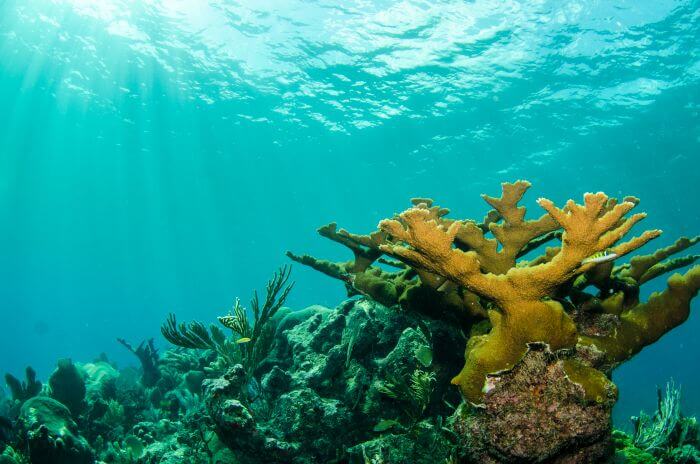
Corals are colourful and vibrant sea creatures, and marine tourism is majorly attributed to this facet. But how are they bright, and why does the colour change occasionally?
Corals can feed in 2 main ways- by capturing zooplankton that floats near their polyp tentacles or by their symbiotic relationship with zooxanthellae.
The latter is microscopic algae that grow within corals and share a symbiotic relationship with the polyp. Zooxanthellae are photosynthetic organisms that require sunlight to live.
They produce nutrients they share with the polyp, while the polyp offers protection in exchange.
The zooxanthellae are of different colours based on their species and chlorophyll’s presence. The main colours adopted by the algae are brown and green, but vibrant colours occur because of environmental changes.
As the temperature and light conditions change, zooxanthellae change their colour across a wide spectrum to act as a form of protection (against UV rays).
Reefs that grow close to the surface are more colourful since the algae can use more sunlight efficiently.
7. Coral Reefs Thrive Where Strong Currents Exist
Corals grow mainly in tropical regions and especially in areas that experience strong currents. This puzzled scientists since most organisms strived to avoid the strong currents that posed various problems. Yet, corals often grow in these locations. Based on several studies conducted in the 1900s, a plausible and widely accepted theory was put forward.
Currents are directly related to the surface temperature. A strong current can ensure cool water circulation faster and more efficiently than a weaker current.
Corals are susceptible to temperature changes. They die quickly if the mercury rises above a certain amount (depending on the reef’s location).
Since strong currents keep the water cool (especially the surface), corals grow in such locations as they can be assured of a cooler and more stable temperature range.
Another point that puzzled scientists was how corals could obtain nutrition. Strong currents bring different creatures to the reef but remove them quickly.
Most creatures do not live in regions with strong currents because the water is nearly devoid of nutrients. Yet, corals thrive in such areas because they feed mainly on plankton and zooplankton trapped within the reef.
Due to the different creatures in the ecosystem, the reef often has an unlimited supply of plankton that other organisms can use. This problem gave rise to the famous Darwin’s Paradox.
8. The Location Of Coral Reefs Gave Rise To Darwin’s Paradox
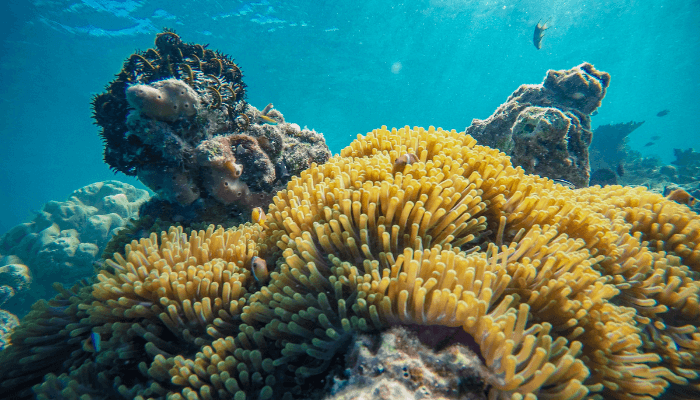
Most organisms on Earth live close to a source of nutrition. From humans living around a waterbody to whales that stay close to zooplankton sites, creatures depend on food for sustenance and energy. However, corals are peculiar in their location.
Darwin, in 1842, noted how corals seemed to flourish in areas with violent currents and strong water movement. This makes the water devoid of natural minerals, but corals seem to thrive in this condition.
Moreover, corals grow in the tropics, which have a slower rate of nutrient replenishment. This is partly because of the slow breakdown of organisms and the creation of thermoclines that prevent the vertical passage of nutrients.
Yet, coral reefs are filled with different species that require nutrients. The food chain is complex within reefs, and the starting point is marine plants and dissolved nutrients.
So, how could the coral reef without nutrients support an extensive ecosystem of organisms that need nutrients?
The now-accepted explanation for Darwin’s Paradox is that coral reefs excel in recycling nutrients in a closed biosphere. Unlike other locations, corals of the tropics that live in remote regions can ensure a near-steady supply of nutrients within the reef.
Phytoplankton and zooplankton form the base of the food chain. Polyps, fish, and crustaceans consume them. Sponges that live in the reef can filter the water and excrete nutrients that corals can use.
Various other organisms in the reef also contribute to the efficient cycling of nutrients. Thus, while coral reefs may live in areas with poor nutrient content, they can produce their minerals and effectively recycle them within the ecosystem.
9. Coral Reefs Help To Filter And Improve The Quality Of Seawater
Polyps are notoriously sensitive to minute changes in the environment. Temperature, salinity, pH, and particulate matter concentration changes can cause the polyp to die.
For this reason, corals have an in-built system to act as a filtration system. They use minuscule sieves that line the coral shell to remove particulate matter. They also adapt to minor changes in temperature and salinity.
Due to their inherent ability to improve water quality (for their survival), they also positively impact the local ecology. Organisms within a coral reef benefit from this and can obtain clean and filtered water.
As the number of corals increases in the reef, they can process larger quantities of water and improve filtration. Also, once a polyp dies, the coral skeleton continues to provide partial filtration.
The downside of this filtration is that organisms within the reef become susceptible to significant environmental changes. They have evolved to survive in the comforts of clean and filtered water but might not be able to adapt in case of a temperature change. The same goes for the polyp, which becomes dependent on extensive filtration for its survival.
10. Coral Reefs Stabilize The Seabed
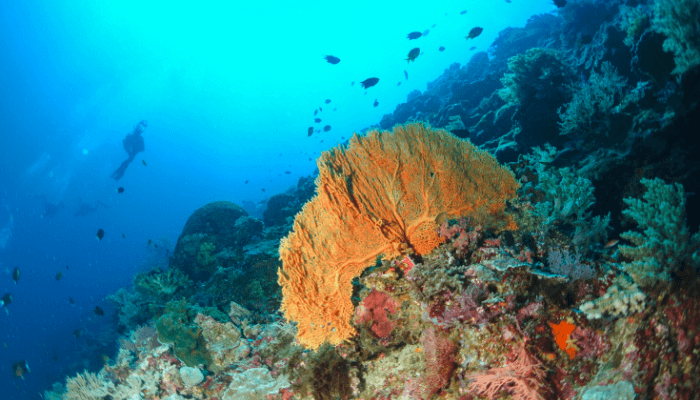
With massive levels of sand mining, the sea bed has gradually become unstable over the past few decades. To aggravate the situation, human activities have also begun to cause erosion.
Corals are an excellent natural control for erosion since they grow across the sea bed. They help stabilize and prevent large swathes of land from shifting.
The polyps that form the core of the coral embed their pedal discs in the substratum. Over millions of years, the calcium secretion has embedded the complete coral reef.
Even when corals die, they continue to provide essential protection to the sea bed against erosion. However, the dead polyp does not generate its shell anymore, meaning the reef will dissolve over time.
Because of stabilizing the ocean bed, coral reefs prevent beach erosion and form a bedrock for islands. Some coral reefs can absorb over 95% of incident wave energy.
They act as a buffer or natural barrier for the beach and protect shorelines from eroding wave action. Thus, coral reefs prevent loss of life and property by stabilizing the sea bed.
11. The Great Barrier Coral Reef Can Be Seen From Outer Space
The Great Barrier Reef of Australia is the largest coral reef system in the world. It has been designated a World Heritage Site and is one of the world’s seven natural wonders. Located off Queensland, it spans nearly 350,000 square kilometres and has almost 3,000 individual reef systems.
With over 900 islands comprising the Great Barrier Reef, it can be seen from outer space and is the largest single structure made by living organisms. The reef is home to billions of corals and millions of species of marine life. From whales and tortoises to underwater snakes and common fishes, it is one of the largest ecosystems on Earth.
Today, the coral reef is only half what it used to be in the 1980s. This has been attributed to widespread bleaching brought about by pollution. Nevertheless, there are extensive efforts by the government of Australia and international non-governmental organizations to save the reefs.
12. The Red Sea Coral Reef Is Highly Resistant To Temperature Changes And Bleaching Bacteria
The Red Sea, located in the South of the Suez Canal and between countries such as Egypt, Saudi Arabia, and Eritrea, is famous for its coral reefs. With a distinctive reddish hue, they give the Sea its peculiar name.
The corals also house the bacteria Trichodesmium Erythraeum that bloom near the surface and are responsible for the red colour visible. The coral reefs of the Red Sea extend over 2 kilometres in length and are brightly coloured. These reefs are unique in their structural formation and are different from classical reef formations.
The main reason for this is the widespread tectonic activity that occurs here. These reefs’ ages are estimated to be between 5,000 – 7,000 years. To protect these species of corals, the Ras Mohammed National Park was set up by the government of Egypt.
A unique feature of coral reefs is their resistance to high temperatures and infection. While temperature resistance can be attributed to natural selection over millions of years, its ability to resist deadly diseases is astonishing.
A bacterium known as Thalassomonas Loyola is known for causing a deadly infection, particular to corals of the species Favia Favus, known as white plague. It bleaches the corals, effectively killing them.
While the rates of coral bleaching are very high in most other reefs worldwide, the Red Sea corals have a meagre rate of only 9% infection.
The reason behind this is the presence of an inherent natural virus known simply as BA3, which can kill the bacterium. Currently, research is being conducted into the feasibility of using BA3 to stop bleaching at other coral reefs.
13. They Are Integral To The Local Tourism Industry
Corals are colourful, house species of marine flora and fauna, and present a great diving experience. These factors make them popular for tourists, with an estimated 70 million visitors from all over the world annually. People visit the coral reef sites for recreation activities like diving, snorkelling and swimming.
Moreover, since colonial corals are rare, this has contributed to the burgeoning interest in reef tourism.
The global tourism industry that directly and indirectly stems from coral reefs has been estimated at $36 billion annually. In such cases, the main sources of revenue from coral tourism are digital outreach and income from secondary industries.
However, in recent times, efforts have been taken directly o restrict human interaction with the coral. Many tourists unwittingly transmit diseases to the corals, destroying entire reefs.
Not common diseases that affect our system, but products such as sunscreen, lotion, metals in their belongings, etc., could potentially harm the polyp.
14. Coral Reefs Play A Role In Hurricane And Storm Mitigation
Alongside their immense importance to the tourism industry, coral reefs are integral in mitigating the effects of hurricanes and storms. Scientists have directly mapped the correlation between coastline protection and the health of the coral in the region.
During the series of hurricanes that struck the Eastern coastline of North America and the Caribbean in the 2000s, regions with coral reefs could weather the storm better.
Coral reefs offer coastal protection. They can mitigate energy by nearly 97%, meaning that the harmful effects of tsunamis and storms can also be controlled. This phenomenon is also easily visible- the water inside a lagoon is always calmer than the water outside the reef.
Interestingly, corals perform the same function as breakwater embankments built outside ports. Countries in hurricane and storm-prone regions can reduce the damage to life and property by nearly 30% by having just a few tens of meters of corals extending from the coastline.
After a few hundred meters, this goes up to nearly 57%. (Reference: Fiorenza Micheli, “Coral reefs protect from storms and rising sea levels”, Stanford Report, May 13, 2014.
15. Corals Can Be Used For Their Medicinal Properties
Corals have been used for medicinal purposes since ancient times. While the myths surrounding the efficacy of corals as a means of curing diseases are often exaggerated or unfounded, scientists have discovered that they possess specific medicinal properties. These are known as their ecosystem services and are invaluable.
Since corals worldwide face mass extinction due to climate change, changing ocean temperatures and pollution, there are strict regulations on the use of corals in medicine. Nevertheless, certain countries allow the use of corals in local or traditional medication.
The earliest origins are in Indian medicine, where the coral calx was known in Sanskrit as Praval Bhasma. It was commonly used to treat bone disorders, calcium deficiencies, and metabolism imbalances. In other cultures, calcium carbonate derived from the coral shell was powdered and used to alleviate ulcers and other digestive system disorders.
Today, coral shells are used in bone grafting to provide a base for the body to heal complex fractures. It is also used to treat certain symptoms associated with diseases and medical conditions such as AIDS and cancer.
It is commonly used for physiotherapy and to reduce pain by powdering and mixing with other concoctions.
Frequently Asked Questions about Coral Reefs
1. What is unique about coral reefs?
They are one of the biologically diverse ecosystems on Earth, rivalled only by tropical rainforests. They are made of soft or hard corals, sponges, fish species, molluscs, sea turtles, crustaceans, etc.
2. What is so cool about coral reefs?
Corals cover less than a per cent of the ocean but house over 25 % of all identified marine species. The coral formations serve as homes to millions of fish, small plants and other microscopic life.
3. What is the importance of coral reefs?
Coral reefs support marine organisms, protect coastal areas from tsunamis and storms and also support the tourism industry. They act as barriers and protect coastal regions from strong and powerful waves.
4. How do corals benefit humankind?
Corals are one of the most beautiful marine creatures. They beautify our planet and are used in modern medicine, support commercial fisheries, and preserve marine biodiversity.
5. What are some characteristics of corals?
Corals usually grow in colonies and are vibrant and colourful. Also, they are animals and not plants! They have natural pigments which produce colours like white, blue, red, orange, yellow, green and purple. Also, algae living in these corals may make them appear brown, green or orange.
6. There are how many types of coral reefs?
There are four types of coral reefs, namely, fringing reefs, barrier reefs, platform reefs and atolls or circular reefs. Some famous reef systems in the world include the Great Barrier reef in Australia, the Mesoamerican Barrier reef system and the Florida Keys Reef Tract.
You might also like to read:
- 10 Gulf Of Aden Facts You Must Know
- 10 Caspian Sea Facts You Must Know
- 10 Gulf Of Mexico Facts You Must Know
- 5 Strait of Magellan Facts You Must Know
- 6 Bosphorus Strait Facts You Must Know
- What Are Tide Pools?
Disclaimer: The author’s views expressed in this article do not necessarily reflect the views of Marine Insight. Data and charts, if used in the article, have been sourced from available information and have not been authenticated by any statutory authority. The author and Marine Insight do not claim it to be accurate nor accept any responsibility for the same. The views constitute only the opinions and do not constitute any guidelines or recommendations on any course of action to be followed by the reader.
The article or images cannot be reproduced, copied, shared or used in any form without the permission of the author and Marine Insight.
Do you have info to share with us ? Suggest a correction
Subscribe To Our Newsletters
By subscribing, you agree to our Privacy Policy and may receive occasional deal communications; you can unsubscribe anytime.
Web Stories

About Author
Ajay Menon is a graduate of the Indian Institute of Technology, Kharagpur, with an integrated major in Ocean Engineering and Naval Architecture. Besides writing, he balances chess and works out tunes on his keyboard during his free time.








